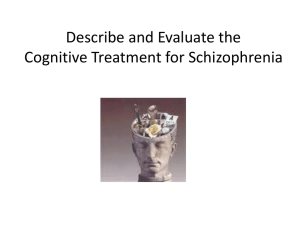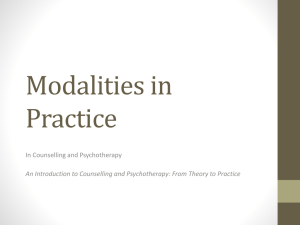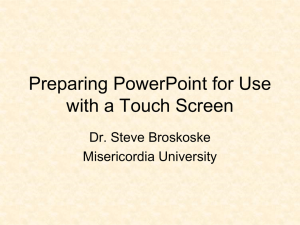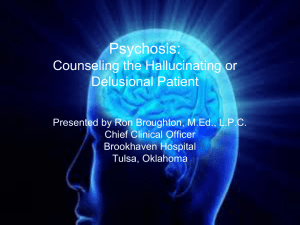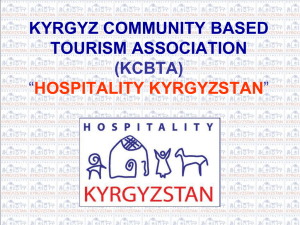Basic Psychological Treatments - Yorkshire and the Humber Deanery
advertisement
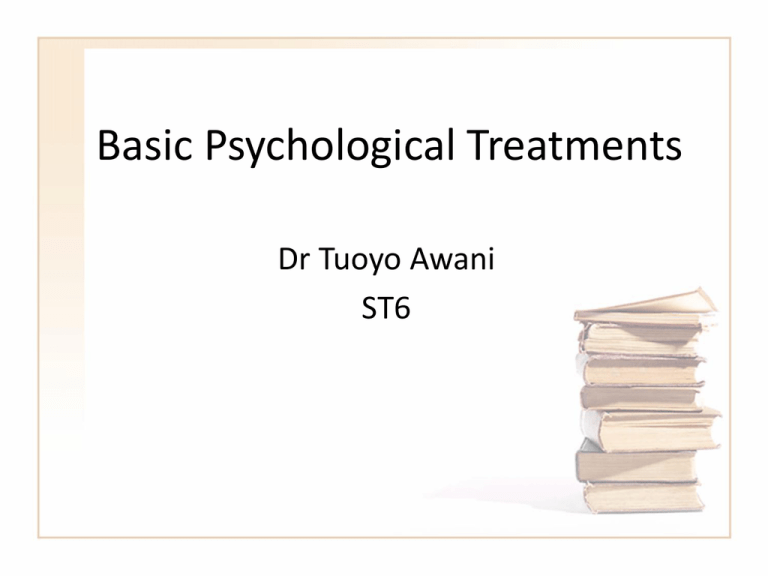
Basic Psychological Treatments Dr Tuoyo Awani ST6 Outline • Gain a basic understanding of different main psychotherapies • Only cover psychodynamic therapy and CBT very briefly, as other lectures on these • Know the indications for different therapies • Know the key techniques and concepts • Know the important names • Practice psychotherapy related exam questions Characteristics of different psychotherapies • Practicalities: How many sessions? How often? • Structure: How structured? Is there homework? • Key ideas: What does therapy focus on? What is the theory behind it? • Interventions: What are the main treatment methods? • Indications: What problems or diagnoses is it suitable for? Psychodynamic Psychotherapy (Freud, Jung, Klein, Winnicott) • Practicalities: – Brief / focal therapy (Balint, Malan): 4-6 months, 1-2 times/week – Long-term exploratory therapy: 1 year or more • Structure: – Relatively unstructured, without homework • Key ideas: – Understand aspects of problem previously unaware of (unconscious conflict) – Aims is more broad than removing single symptoms or problem behaviours Psychodynamic Psychotherapy 2 • Interventions: – Discuss past and recent problems, therapists suggests links between these (interpretations) – Therapeutic relationship central and discussed: • patient transfers feelings and attitudes from past relationships onto the therapeutic one (transference) • therapist notes their feelings and attitudes towards the patient (countertransference) – Therapist is able to tolerate difficult emotions Psychodynamic Psychotherapy 3 • Indications: – Evidence base relatively poor – Difficulties in relationships, low self esteem – Patients who have some insight and motivation – Patients who understand the problem in psychological terms (at least partly) – Patients able to cope with feelings evoked in therapy (ego strength) – Patients with some capacity to form and maintain relationships Behavioural / Cognitive behavioural therapy (Beck) • Practicalities: – Usually 10-20 sessions – Weekly, approx 1 hour • Structure: – Structured – Collaborative, therapist guides discovery, teaches skills Behavioural / Cognitive behavioural therapy 2 • Key ideas: – Focuses on current problems – Behaviour therapy: reactions can be linked to stimuli eg. phobias (classical conditioning, Pavlov), – Reinforcement/punishment of behaviours affects their frequency (operant conditioning, Skinner) – Cognitive therapy: Thoughts, emotions, physical symptoms and behaviours are linked, altering one will have a knock on effect on the others – Past experiences lead to core beliefs and dysfuctional assumptions, which influence our thoughts and behaviour in the present Behavioural / Cognitive behavioural therapy 3 • Interventions: – Behavioural interventions eg. Graded exposure, ERP, activity scheduling, behavioural experiments – Cognitive interventions eg. Evidence for and against thoughts, thinking biases, working on core beliefs and assumptions • Indications: – Depression, anxiety, PTSD, eating disorders, schizophrenia Dialectical behavioural therapy (DBT) (Linehan) • Practicalities / Structure: Approx 1year – Group skills training: approx 2.5 hours/week – Individual psychotherapy • Key ideas: – Patients need new ways of solving problems – Validate patient’s thoughts, feelings and actions • Interventions: – – – – – Core mindfulness skills Interpersonal effectiveness skills Emotion regulation skills Distress tolerance skills Look at applying skills and motivational issues in individual therapy • Indications: – Borderline personality disorder Cognitive analytic therapy (Ryle) • Practicalities: Usually16 or 24 sessions • Structure: Some structure, reformulation diagram central • Key ideas: – Identifies reciprocal roles – Identifies procedural loops – Patient actively involved in the process • Interventions: – Reformulation letter – Techniques from dynamic and cognitive behavioural therapy • Indications: – Small evidence base – Borderline personality disorder, eating disorders Procedural loop in CAT Courtesy Wikipedia 2014 Interpersonal Therapy (IPT) (Klerman & Weissman) • Practicalities: 12-20 sessions • Structure: • 1st phase: information gathering, psychoeducation, interpersonal inventory and chart, select a focus • 2nd phase: Active work on role transition, role conflict, grief or interpersonal deficits • 3rd phase: Relapse prevention, grief over ending, transition to independence • Key ideas: Interpersonal problems are central to many psychiatric problems • Interventions: • Link symptom change to interpersonal events • Experiment with new interpersonal strategies • Indications: depression, Eye movement desensitization and reprocessing (Shapiro) • Practicalities: Usually about 3-12 sessions • Structure: Set phases to work through • Key ideas: Eye movement enhances the processing of traumatic memories by • • • • increases interaction of 2 brain hemispheres or/ activates a state similar to REM sleep or/ keeps some focus on current reality or/ not an active component • Interventions: – Self-soothing techniques in preparatory phase eg. safe place image or memory – Bilateral stimulation eg. moving eyes back and forth inducing saccadic eye movement – Attending to a disturbing memory briefly (15-30 secs) – Linking a positive thought to the image • Indications: PTSD Motivational interviewing (Miller, Rollnick) • Practicalities: 1:1 • Key ideas: Client-centred but semi-directive – Confrontation and persuasion increase resistance – Reluctance seen as natural and not a client trait – Increases self-efficacy and explore ambivalence • Interventions: • Empathy, rolls with resistance, affirmation • Reflective listening with focus on change talk – Explores discrepancy between now & future goals • Indications: • Eliciting behavioural change • Especially drug and alcohol problems • Stages of change: precontemplation or contemplation stages Family therapy • Practicalities: (Extended or nuclear) family group • May use a 2 way mirror, with a reflecting team • Key ideas: Problems are generated by malfunction of the family system, not one individual • Focuses on patterns of relationships , not causes or diagnoses • Focuses on what goes on between persons rather within a person • SYSTEMIC (MILAN SCHOOL) • • • • Symptoms have a function & stabilise the system Circular and reflexive questioning Focuses on belief systems Difficulties not with individual, but with family system • STRATEGIC (HALEY) • • • • Patterns of interactions between family members Solutions often perpetuate problems Relabel symptoms as helpful Prescribe symptoms Family Therapy 2 • STRUCTURAL (MINUCHIN) • Looks at family rules, coalitions, boundaries and power hierarchies • “Normative” family structure: hierarchy between generations, semipermeable boundaries • Position family members or make some observers to disrupt dysfunctional relationships • Challenges rigid or absent boundaries • OTHER MODALITIES: problem solving approaches, dynamic methods, cognitive behavioural, trans generational therapy • Indications: Child and adolescent mental health problems, eating disorders, schizophrenia, marital problems Group Therapy Pratt, Burrow Schilder • MANY MODALITIES – Psychoeducation groups – CBT based groups – 12 step groups eg. Alcoholics anonymous – Self-help groups – Non verbal expressive groups (art, music etc) – Psychodrama (Moreno) • PSYCHODYNAMIC GROUPS • Group used to develop and explore interpersonal relationships • Bion: Basic assumptions in groups • Dependence: on therapist to solve problems • Pairing: hoping for a pairing to solve group problems • Fight-flight: retreating or battling with others Therapeutic factors in Groups (Yalom) • Instillation of hope: inspiration from others recovering • Universality: shared experiences • Imparting of information • Interpersonal learning: feedback from others increases self-awareness • Altruism: helping others increases self-esteem • Corrective recapitulation of the family group: transference from family experience to therapy group • Development of socialising techniques THERAPEUTIC FACTORS IN GROUPS (YALOM) cont • Imitative behaviour: learning through modelling eg. sharing emotions, showing concern • Group cohesiveness: acceptance and validation (suggested as the primary therapeutic factor in group therapy) • Catharsis: relief through expression of emotion. • Existential factors: Learning the need to take responsibility for one's own life and decisions • Self-understanding: causes of own problems and motivations behind own behavior. THERAPEUTIC COMMUNITIES (MaxwellJones, Foulkes) • • • • Usually residential (therapist and patients) Increasingly now supported heavily with day units Group psychotherapy and practical activities Moderate to severe personality disorder, complex emotional and interpersonal problems • Emerging funding constraints threatening the core implementation of TC, and forcing some to close • 4 PRINCIPLES IN TC TREATMENT (RAPAPORT) – – – – Permissiveness: tolerance of behaviour Reality-confrontation: feedback from others Democracy: shared decision-making Communalism: close, shared living Depression 1 • • • • Therapy efficacy 50-60%, group & individual similar Relapse 50% over 1 year, less with booster sessions Approximately equivalent to medication, Medication may be more effective in the severely depressed • NICE SUGGESTS: • Mild: guided self help, computerised/brief CBT, counselling • Moderate / severe: antidepressant priority – – – – – – Consider therapy if refuse antidepressant or poor response Consider medication and CBT together in severe depression CBT 1st choice of psychological intervention, 16-20 sessions IPT if preferred by patient or clinically indicated Couple focused therapy if individual ineffective Mindfulness based CBT in recurrent depression Bipolar affective disorder NICE suggests • Moderate depression, not responding to medication: – Structured psychological therapy – Focus on depressive symptoms, problem solving, social functioning, medication concordance • Ongoing mild-moderate affective symptoms: – Structured psychological therapy, 16+ sessions over 6-9 months – Focus on routine, concordance, psychoeducation, monitoring mood, early warning symptoms, coping strategies – Family focused intervention, over 6-9 months – Focus on psychoeducation, improving communication, problem solving Anxiety disorders 1 • CBT recommended for all • Panic disorder/agoraphobia (7-14 sessions): – Agoraphobia needs exposure • Generalised anxiety disorder (16-20 sessions): – Cognitive methods and applied relaxation have evidence • Obsessive compulsive disorder: ERP – Stepped approach based on functional impairment – Less effective without compulsions, hoarding • Social anxiety disorder: – Thoughts, safety behaviours, attentional processing – Group and individual therapy similar efficacy Post-traumatic stress disorder (PTSD), NICE suggests • Psychological debriefing may be harmful • Trauma focused CBT • EMDR (Eye movement desensitisation and reprocessing): 3 months or more after event • Needs to include exposure • Usually 8-12 sessions • 90 minute sessions when trauma discussed Anorexia nervosa, NICE suggests • Adults: Focal dynamic psychotherapy, CAT, CBT, IPT Family interventions focused on eating problems, 6 months or more of therapy • Children / adolescents: Family interventions focused on eating problems Individual appointments for the young person BULIMIA NERVOSA, NICE SUGGESTS • CBT, 16-20 sessions • If ineffective or declined IPT (takes longer to achieve results) Borderline personality disorder • Evidence for dialectical behaviour therapy (DBT) – focuses on behaviours esp. impulsivity and suicidality • Evidence for structured psychodynamic approach, including group treatment: – may have more impact on mood and interpersonal functioning • CAT, Schema-focused CBT need more research • NICE suggests: – explicit, integrated theoretical approach – Same approach team and therapist – Up to 2x/week, not usually less than 3 months Schizophrenia, NICE SUGGESTS • • CBT (16+ sessions) for all patients, NICE suggests Evidence for CBT: – – – – In acute episodes may shorten episodes & reduce symptoms In chronic patients improves mental state Doesn’t alter relapse or readmission rates Possible adverse impacts in vulnerable individuals • Family interventions (10+ sessions) when close contact with family, NICE suggests – Include problem solving or crisis management work – Evidence suggests CBT based sessions • Art therapies recommended for consideration by NICE – Especially if negative symptoms MCQ 1 • An otherwise fit and intelligent 23 year old man has features of a moderate depressive illness. The correct initial treatment according to NICE is: A. CBT B. SSRI C. CBT + SSRI D. TCA MCQ 3 • Which of the following is true regarding CBT: A: CBT has been shown to be as effective as treatment with antidepressants in depression of moderate severity. B: CBT is the preferred treatment for borderline personality disorder C: CBT is the only psychological intervention recommended by NICE for anorexia nervosa D: Antidepressants should be used before CBT in the treatment of PTSD E: CBT is not effective in social phobia MCQ 4 • Which of the following is correct: A: Psychodynamic therapy is effective in schizophrenia B: Individual therapy is usually more effective than group therapy C: Cognitive therapy is effective for agoraphobia D: There is evidence for cognitive analytic therapy in anorexia nervosa E: Unstructured psychotherapy is recommended in bipolar affective disorder MCQ 5 • Which of the following is true regarding CBT: A: Incorrect theory of mind is part of the CBT model B: Underlying assumptions are process that belong to the dynamic unconsciousness C: CBT is non-directive D: In exposure and response prevention obsessions are resisted E: Behavioural experiments are used to test out negative cognitions EMQ 1 A: Mindfulness CBT B: Exposure and response prevention C: Graded Exposure D: Schema focused CBT E: Activity scheduling F: Functional analysis G: Trauma focused CBT • Identify the most appropriate technique / approach from those listed for each of the scenarios below: 1: A 25 year old woman with a diagnosis of borderline personality disorder 2: A 42 year old man with severe depression who lacks motivation and has poor concentration 3: A 33 year old man with a recurrent depressive illness who has experienced a relapse despite antidepressant medication and tends to ruminate about his problems 4: An 8 year old girl with a phobia of vomiting who is avoiding many things which she associates with a risk of vomiting EMQ 2 • A: Ryle B: Beck C: Linehan D: Klein E: Wolpe • Which of the people above is associated with each of the therapies or interventions listed: 1: Psychodynamic psychotherapy 2: Cognitive analytic therapy 3: Dialectical behavioural therapy 4: Cognitive behavioural therapy EMI 3 Types of family therapy A: Cognitive B: Dialectical C: Dynamic D: Strategic E: Solution focused F: Structural G: Eclectic H: Systemic Select which type of therapy is described in each scenario below: 1. The therapist is identifying, ascertaining and developing a firm family hierarchy 2. An emotionally intertwined family of an adolescent with anorexia nervosa need the forces and beliefs which influence their behaviour towards each other to be revealed 3. A family are helped with a novel practical strategy to break the negative cycles of behaviour identified in therapy. The therapist views the problems as dysfunctional communication. EMQ 4 • A: Thinking biases B: Transference C: Reciprocal roles D: Mindfulness E: Dysfunctional assumptions F: Circular questioning G: Interpersonal role disputes • Which of the above features or concepts is associated with the therapy below: 1: Cognitive analytic therapy 2: Dialectical behavioural therapy 3: Psychodynamic psychotherapy EMI 5 • Psychological treatment in group settings: A. Cohesiveness F. Dependence B. Vicarious learning G. Fight-flight C. Counter-dependence H. Pairing D. Free floating discussion I. Universality E. Interpreting transference J. Conditioning From the options above, Choose 1. Two curative factors in group therapy. 2. Three factors that hinder working in groups. 3. Two factors that are found in psychodynamic groups. EMQ 6 • A: Eye movement desensitisation and reprocessing B: Brief psychodynamic psychotherapy C: Interpersonal therapy D: Cognitive behavioural therapy with exposure and response prevention E: Family interventions • Which of therapies above is recommended by NICE for the disorder below: 1: Depression 2: Schizophrenia 3: Post-traumatic stress disorder 4: Obsessive compulsive disorder ST1-3 Psychotherapy requirements • CBD group: 30 sessions • Psychotherapy cases: 2 of different modalities and durations Year Psychotherapy Experience WPBA End CT1 Attended first 6 months of a case based discussion group 1st (6 month) CBD End CT2 Finish 12 months of case discussion group Short case completed or Half-way through a long case 2 CBD sheets (6 & 12 months) 1 set of SAPEs for short case or halfway SAPE for a long case End CT3 2 cases completed 2 sets of SAPEs Psychotherapy ACE Thanks For Listening


